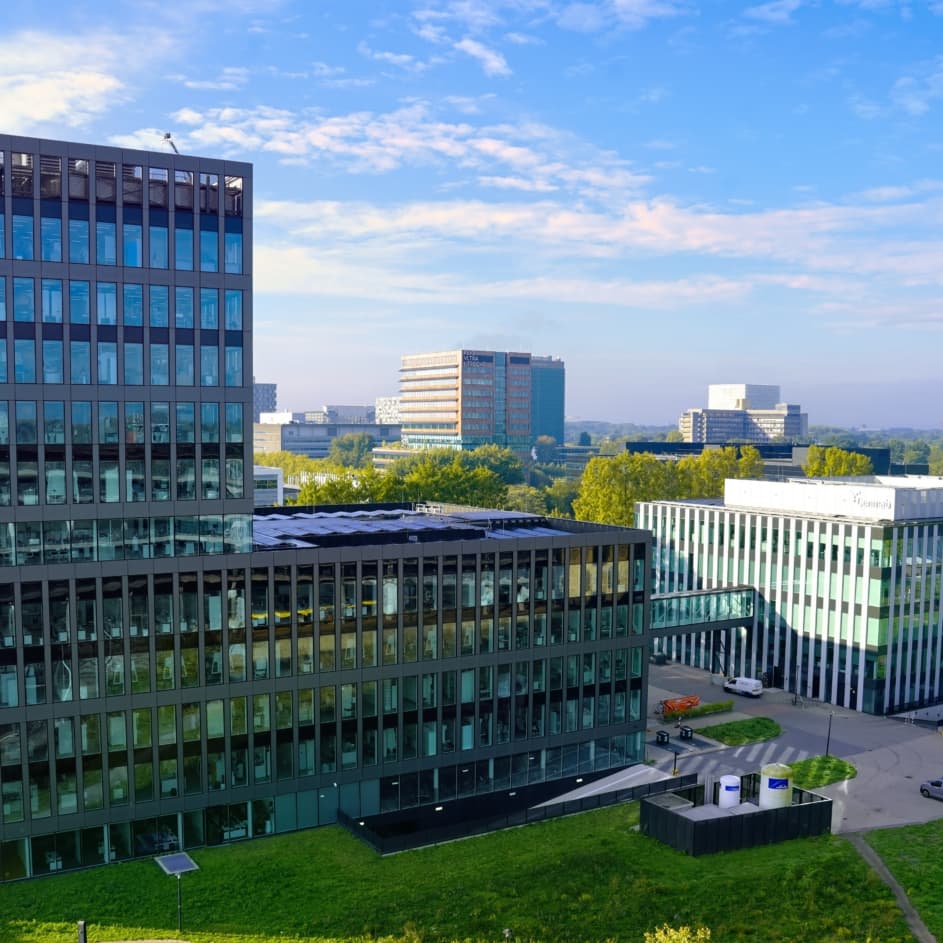In the media: Utrecht Science Park as a ‘powerhouse’ of the biotech sector

Following the proposed merger of Utrecht Science Park companies Genmab and Merus, several media outlets have published articles highlighting the strength of the Utrecht Science Park ecosystem. For example, the Financieele Dagblad discussed the “biotech powerhouse” and the importance of growth opportunities to ensure this knowledge remains in the Netherlands.
A fertile ecosystem for innovation
With 31,000 employees and 55,000 students, Utrecht Science Park is the biggest science park in the Netherlands. Within this close-knit ecosystem, aptly dubbed “the golden square kilometer” by Mayor Sharon Dijksma, leading organizations collaborate closely within walking distance of each other. An example of the economic impact of this network is the recently announced acquisition of the Utrecht Science Park-based biotech company Merus by its neighbor Genmab for nearly €7 billion. Genmab is led by Jan van de Winkel. Merus was founded by Ton Logtenberg, who was previously a professor of immunology at Utrecht University at the same time as Van de Winkel. “If it had been acquired by a foreign pharmaceutical company, there was a good chance that Merus and all its activities would have left the Netherlands,” says Ton Logtenberg. “This deal will help Utrecht become a true powerhouse of the biotech sector,” says Sebastiaan van der Schoot, financial analyst at investment bank Van Lanschot Kempen. Jan van de Winkel also indicates that this acquisition will give new medicine development in the Netherlands a tremendous boost: “This is an exceptionally powerful conglomerate of research and drug development capacity. Genmab has built an impressive track record, and now we will be bringing our own medicines to market. I think that’s very good for the Netherlands.”
Strong scientific base
What makes Utrecht Science Park so unique is its strong combination of knowledge institutions, (academic) healthcare institutions, research institutes, and R&D companies. This strong scientific base is formed by Utrecht University (one of Europe’s leading research universities), University Medical Center Utrecht (one of the largest public healthcare institutions in the Netherlands), and the Princess Máxima Center (Europe’s largest center for pediatric oncology), supplemented by leading research institutes such as the Hubrecht Institute, the Westerdijk Institute (both KNAW), RIVM (National Institute for Public Health and the Environment), and TNO (Netherlands Organisation for Applied Scientific Research).
Education and talent
With more than 55,000 students, Utrecht Science Park is a major source of talent. More than 12,000 people graduate annually, contributing to the regional labor market and an attractive business climate. For example, the Graduate School of Life Sciences, with nearly 4,000 PhD and Master’s students, is the largest in Europe. The young, highly educated population has helped make the Utrecht region one of the most competitive in Europe (Regional Competitiveness Index, 2022). Through internships, challenges, and educational programs, Utrecht University and Utrecht University of Applied Sciences encourage collaboration between students, companies, and institutions. University-affiliated organizations such as UtrechtInc and the Centre for Entrepreneurship also support students and startups in converting knowledge into entrepreneurship.
Job Engine
Utrecht Science Park plays a crucial role in job growth and new business activity. According to a 2024 report by Buck Consultants International, the park is a major job engine (from vocational education to university education) for the city, region, and country. With over 31,000 employees, it is the largest science park in the Netherlands. Since 2018, employment at R&D companies has grown by 76%, almost three times faster than the Utrecht average, and the number of companies has increased by 64%. This emphasizes the importance of continued investment in knowledge and innovation.
Investments
Utrecht Science Park, with its innovation ecosystem, makes a significant contribution to national and European policy goals. Investments in R&D and innovation are essential because they contribute to a resilient economy and the preservation of public services. The park is a vital center for economic and social impact and builds on strong research and innovation centers. It distinguishes itself particularly in R&D and innovations in biotechnology and medical technology, with expertise in areas such as oncology (immuno-, cell-, and gene therapy), regenerative medicine, organoid and stem cell research, infectious diseases, and AI applications.
Would you like to read some publications? View the links below (note: in Dutch and login is sometimes required):

Registration for the HiPRO Utrecht Marathon 2026 Now Open
On Sunday, 31 May 2026, Utrecht will once again revolve around the HiPRO Utrecht Marathon, supported by Utrecht Science Park.

Laigo Bio at Utrecht Science Park raises €11.5 million in investments
Laigo Bio, a start-up located at Utrecht Science Park in the Life Sciences Incubator building, announced today that it has raised €11.5 million in investments from a large number of leading investors.

Wennink plan: Life Sciences and biotechnology are important growth drivers for the earning capacity of the Netherlands
The Dutch Life Sciences and biotechnology sector can make a much larger contribution to the Netherlands’ economic strength. This is shown in a new growth strategy presented today as part of Peter Wennink’s advisory report. The report also highlights Utrecht Science Park as one of the key innovation locations and sources of progress and growth.
